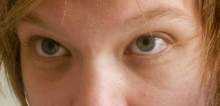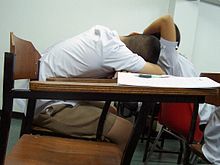- Fatigue (medical)
-
"Exhaustion" redirects here. For other uses, see Exhaust (disambiguation).
Fatigue
Occupations that require an individual to work long hours or stay up overnight can lead to fatigue.ICD-10 R53 ICD-9 780.7 DiseasesDB 30079 MedlinePlus 003088 MeSH D005221 Fatigue (also called exhaustion, lethargy, languidness, languor, lassitude, and listlessness) is a state of awareness describing a range of afflictions, usually associated with physical and/or mental weakness, though varying from a general state of lethargy to a specific work-induced burning sensation within one's muscles. Physical fatigue is the inability to continue functioning at the level of one's normal abilities.[1][2][3] It is widespread in everyday life, but usually becomes particularly noticeable during heavy exercise. Mental fatigue, on the other hand, rather manifests in somnolence (sleepiness).
Fatigue is considered a symptom, as opposed to a medical sign, because it is reported by the patient instead of being observed by others. Fatigue and ‘feelings of fatigue’ are often confused.[4]
Contents
Classification
Physical fatigue
Physical fatigue or muscle weakness and/or aches, (or "lack of strength") is a direct term for the inability to exert force with one's muscles to the degree that would be expected given the individual's general physical fitness.
A test of strength is often used during a diagnosis of a muscular disorder before the etiology can be identified. Such etiology depends on the type of muscle weakness, which can be true or perceived as well as central or peripheral. True weakness is substantial, while perceived rather is a sensation of having to put more effort to do the same task. On the other hand, central muscle weakness is an overall exhaustion of the whole body, while peripheral weakness is an exhaustion of individual muscles.
Mental fatigue
In addition to physical, fatigue also includes mental fatigue, not necessarily including any muscle fatigue. Such a mental fatigue, in turn, can manifest itself both as somnolence (decreased wakefulness), or just as a general decrease of attention, not necessarily including sleepiness. Decreased attention is known as ego depletion and occurs when the limited 'self regulatory capacity' is depleted [5]. It may also be described as a more or less decreased level of consciousness.[6] In any case, this can be dangerous when performing tasks that require constant concentration, such as driving a vehicle. For instance, a person who is sufficiently somnolent may experience microsleep. However, objective cognitive testing should be done to differentiate the neurocognitive deficits of brain disease from those attributable to tiredness.
Causes
Fatigue is a normal result of working, mental stress, overstimulation and understimulation, jet lag or active recreation, depression, and also boredom, disease and lack of sleep. It may also have chemical causes, such as poisoning or mineral or vitamin deficiencies. Massive blood loss frequently results in fatigue. Fatigue is different from drowsiness, where a patient feels that sleep is required. Fatigue is a normal response to physical exertion or stress, but can also be a sign of a physical disorder.
Temporary fatigue is likely to be a minor illness like the common cold as one part of the sickness behavior response that happens when the immune system fights an infection.
Chronic fatigue
Prolonged fatigue is a self-reported, persistent (constant) fatigue lasting at least one month. Chronic fatigue is a self-reported fatigue lasting at least six consecutive months. Chronic fatigue may be either persistent or relapsing.[7] Chronic fatigue is a symptom of a large number of different diseases or conditions. Some major categories of diseases that feature fatigue include:
- Autoimmune diseases such as celiac disease, multiple sclerosis, and spondyloarthropathy
- Blood disorders such as anemia and hemochromatosis
- Cancer
- Chronic fatigue syndrome (CFS)
- Drug abuse
- Depression and other mental disorders that feature depressed mood
- Eating disorders, which can produce fatigue due to inadequate nutrition
- Endocrine diseases like diabetes mellitus and hypothyroidism
- Fibromyalgia
- Heart disease
- Irritable Bowel Syndrome
- Inborn errors of metabolism such as Fructose malabsorption.[8][9]
- Liver failure
- Infectious diseases such as infectious mononucleosis.
- Leukemia or lymphoma
- Lyme disease
- Neurological disorders such as narcolepsy, Parkinson's disease and post-concussion syndrome
- Physical trauma and other pain-causing conditions, such as arthritis
- Sleep deprivation or sleep disorders
- Uremia
Fatigue may also be a side effect of certain medications, e.g. lithium salts, ciprofloxacin; beta blockers, which can induce exercise intolerance; and many cancer treatments, particularly chemotherapy and radiotherapy.
Diagnosis
 Minor dark circles, in addition to a hint of eye bags, a combination mainly suggestive of minor sleep deprivation.
Minor dark circles, in addition to a hint of eye bags, a combination mainly suggestive of minor sleep deprivation.
The majority of people who have fatigue do not have an underlying cause discovered after a year with the condition. In those people who have a possible diagnosis, musculoskeletal (19.4%) and psychological problems (16.5%) are the most common. Definitive physical conditions were only found in 8.2%.[10]
If a person with fatigue decides to seek medical advice, the overall goal is to identify and rule out any treatable conditions. This is done by considering the person's medical history, any other symptoms that are present, and evaluating of the qualities of the fatigue itself. The affected person may be able to identify patterns to the fatigue, such as being more tired at certain times of day, whether fatigue increases throughout the day, and whether fatigue is reduced after taking a nap.
Because disrupted sleep is a significant contributor to fatigue, a diagnostic evaluation considers the quality of sleep, the emotional state of the person, sleep pattern, and stress level. The amount of sleep, the hours that are set aside for sleep, and the number of times that a person awakens during the night are important. A sleep study may be ordered to rule out a sleep disorder.
Depression and other psychological conditions can produce fatigue, so people who report fatigue are routinely screened for these conditions, along with drug abuse, poor diet, and lack of physical exercise, which paradoxically increases fatigue.
Basic medical tests may be performed to rule out common causes of fatigue. These include blood tests to check for infection or anemia, a urinalysis to look for signs of liver disease or diabetes mellitus, and other tests to check for kidney and liver function, such as a comprehensive metabolic panel.[11] Other tests may be chosen depending on the patient's social history, such as an HIV test or pregnancy test.
Perception of fatigue
The sense of fatigue is believed to originate in the reticular activating system of the lower brain. Musculoskeletal structures may have co-evolved with appropriate brain structures so that the complete unit functions together in a constructive and adaptive fashion.[12] The entire systems of muscles, joints, and proprioceptive and kinesthetic functions plus parts of the brain evolve and function together in a unitary way.[13]
See also
- Cancer-related fatigue
- Combat stress reaction
- Fatigue (safety)
- Malaise
- Microsleep
- Presenteeism
- Sleep-deprived driving
- Gaucher's Disease
Notes
- ^ Gandevia SC (1992). "Some central and peripheral factors affecting human motoneuronal output in neuromuscular fatigue". Sports medicine (Auckland, N.Z.) 13 (2): 93–8. doi:10.2165/00007256-199213020-00004. PMID 1561512.
- ^ Hagberg M (1981). "Muscular endurance and surface electromyogram in isometric and dynamic exercise". Journal of Applied Physiology 51 (1): 1–7. PMID 7263402.
- ^ Hawley JA, Reilly T (1997). "Fatigue revisited". Journal of sports sciences 15 (3): 245–6. doi:10.1080/026404197367245. PMID 9232549.
- ^ Berrios GE (1990). "Feelings of fatigue and psychopathology: a conceptual history". Compr Psychiatry 31 (2): 140–51. doi:10.1016/0010-440X(90)90018-N. PMID 2178863. http://linkinghub.elsevier.com/retrieve/pii/0010-440X(90)90018-N.
- ^ Baumeister, R. F. (2002). Ego Depletion and Self-Control Failure: An Energy Model of the Self’s Executive Function. Self and Identity, 1, 129-136.
- ^ AJ Giannini Fatigue,Chronic. In RB Taylor Difficult Diagnosis--2. Philadelphia, WB Saunders Co.,1992,pg 156. ISBN 0-7216-3481-8
- ^ Fukuda K, Straus S, Hickie I, Sharpe M, Dobbins J, Komaroff A (15 December 1994). "The chronic fatigue syndrome: a comprehensive approach to its definition and study. International Chronic Fatigue Syndrome Study Group.". Ann Intern Med 121 (12): 953–9. PMID 7978722. http://www.annals.org/cgi/content/full/121/12/953.
- ^ Systematic review of the comorbidity of irritable bowel syndrome with other disorders: What are the causes and implications? In: Gastroenterology, Volume 122, Issue 4, April 2002, Pages 1140-1156. Retrieved Retrieved June 20, 2011.
- ^ Review article: fructose malabsorption and the bigger picture 2006, Wiley Online Library. Retrieved June 20, 2011.
- ^ Nijrolder I, van der Windt D, de Vries H, van der Horst H (November 2009). "Diagnoses during follow-up of patients presenting with fatigue in primary care". CMAJ 181 (10): 683–7. doi:10.1503/cmaj.090647. PMC 2774363. PMID 19858240. http://www.cmaj.ca/cgi/pmidlookup?view=long&pmid=19858240.
- ^ EMedicine Health. "Fatigue Exams and tests" 2010-01-25.
- ^ Edelman, Gerald Maurice (1989). The remembered present: a biological theory of consciousness. New York: Basic Books. ISBN 0-465-06910-X.
- ^ Kelso, J. A. Scott (1995). Dynamic patterns: the self-organization of brain and behavior. Cambridge, Mass: MIT Press. ISBN 0-262-61131-7.
References
- Gandevia SC (1992). "Some central and peripheral factors affecting human motoneuronal output in neuromuscular fatigue". Sports medicine (Auckland, N.Z.) 13 (2): 93–8. doi:10.2165/00007256-199213020-00004. PMID 1561512.
- Hagberg M (1981). "Muscular endurance and surface electromyogram in isometric and dynamic exercise". Journal of Applied Physiology 51 (1): 1–7. PMID 7263402.
- Hawley JA, Reilly T (1997). "Fatigue revisited". Journal of sports sciences 15 (3): 245–6. doi:10.1080/026404197367245. PMID 9232549.
- Edelman, Gerald Maurice (1989). The remembered present: a biological theory of consciousness. New York: Basic Books. ISBN 0-465-06910-X.
- Kelso, J. A. Scott (1995). Dynamic patterns: the self-organization of brain and behavior. Cambridge, Mass: MIT Press. ISBN 0-262-61131-7.
External links
- Fatigue — Information for Patients, U.S. National Cancer Institute
- Tiredness — Information leaflet from mental health charity The Royal College of Psychiatrists
- Is exhaustion an actual medical diagnosis? from Slate.com
Symptoms and signs: general / constitutional (R50–R61, 780.6–780.9) Temperature heat: Fever (Fever of unknown origin, Drug-induced fever, Postoperative fever) • Hyperhidrosis (e.g., Sleep Hyperhidrosis; "Sweating") • Hyperpyrexia • Hyperthermiacold: ChillsAches/Pains Malaise and fatigue Atrophy (e.g., Muscle Atrophy) • Debility (or Asthenia) • Lassitude • Lethargy • Muscle tremors • TendernessMiscellaneous Flu-Like SymptomsCommon cold Viruses Symptoms Sore throat - Rhinorrhea - Nasal congestion - Sneezing - Cough - Muscle aches - Fatigue - Malaise - Headache - Weakness - Loss of appetiteComplications Acute bronchitis - Bronchiolitis - Croup - Pharyngitis - Pneumonia - Sinusitis - Otitis media - Strep throatAntiviral drugs Pleconaril (experimental)Categories:- Exercise physiology
- Symptoms
- Mental processes
Wikimedia Foundation. 2010.

